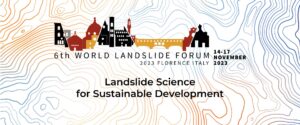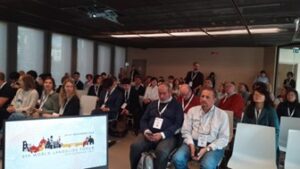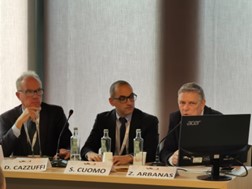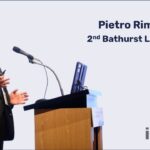Ten speakers from seven countries shared the latest research on how geosynthetics can mitigate landslides at a special session of the 6th World Landslide Forum (WLF).
IGS Italy, known as AGI-IGS, organized the symposium on ‘Advancements in landslide and debris flow mitigation using geosynthetics and other solutions’, which welcomed 90 participants. It was the third such event at the Forum, which takes place every three years to share progress on global landslide risk reduction.
Session co-chair and IGS Italy President Daniele Cazzuffi said: “With advances in manufacturing, and sensing and construction technology there have been significant improvements in ways to mitigate landslide hazards. This session was intended to provide a sharing and discussion platform for those researching, designing, or implementing landslide mitigation works using geosynthetics and related products.”


Speakers were:
- Katia Boschi (Polytechnic University of Milan, Italy), ‘Analytical modelling of the mechanical behaviour between soil and anchored geosynthetic systems’
- Chi Cheng Luo (National Cheng Kung University, Taiwan) ‘3D printed reinforcement for soil stabilization’
- Helene Lanter (Geobrugg AG, Switzerland) ‘Development of a bio-based, biodegradable geotextile’
- Sabatino Cuomo (University of Salerno, Italy) ‘Green protection barriers against debris avalanches’
- Imogen Daysh, (University of Canterbury, New Zealand), ‘How effective was sluicing as a rockfall remediation method following the 2016 Kaikoura earthquake?’
- Nilo L. Dolojan (Graduate School of Civil and Environmental Engineering, Tohoku University, Japan), ‘Application of two-dimensional shallow water equations in debris flow modelling: A case study in Marumori, Miyagi, Japan’
- Taikun Han (University of Hong Kong), ‘Experimental investigation of negative poisson’s ratio structures to arrest geophysical granular flows’
- Shuntaro Nada (Tokyo City University, Japan), ‘Evaluation of slope protection works from shear strain in ground with soil nailing by centrifuge tests’
- Daniele Giordan (National Research Council of Italy), ‘Risks associated with the management of structural protective measures for rockfall mitigation: an overview on their supervision and monitoring over time’
- V. Stammberger (Technical University of Munich, Germany), ‘Predictive modelling of debris flow entrainment in contrasting environmental settings’
Dr. Cazzuffi, who chaired the symposium with coordinator of the international LARAM School, Professor Sabatino Cuomo, and WLF President Prof. Zeljko Arbanas, added: “Our audience learned how slope stability can be increased by geometry modifications, superficial or deep drainage, soil improvement, retaining structures or using geosynthetics. We’re delighted to have been able to offer an opportunity to gain a better insight into the reinforcement mechanisms as well as to validate or improve existing design methods.”
This year’s WLF, on November 14-17 in Florence, Italy, brought together more than 1,200 participants from 68 countries to hear more than 600 oral and poster presentations. The WLF7 will take place in Taoyuan, Taiwan, from April 7-12, 2026.
For more about IGS Italy, visit the Chapter website here.





















